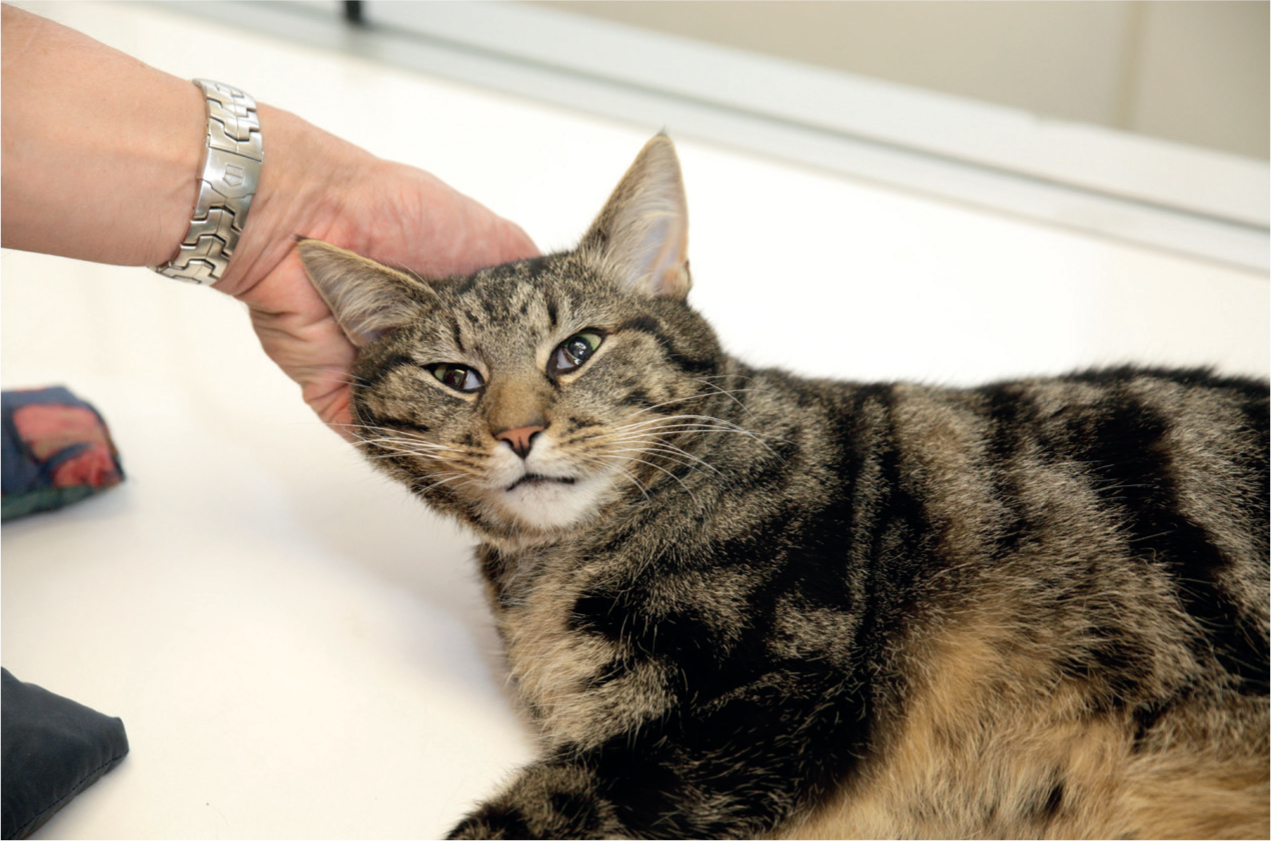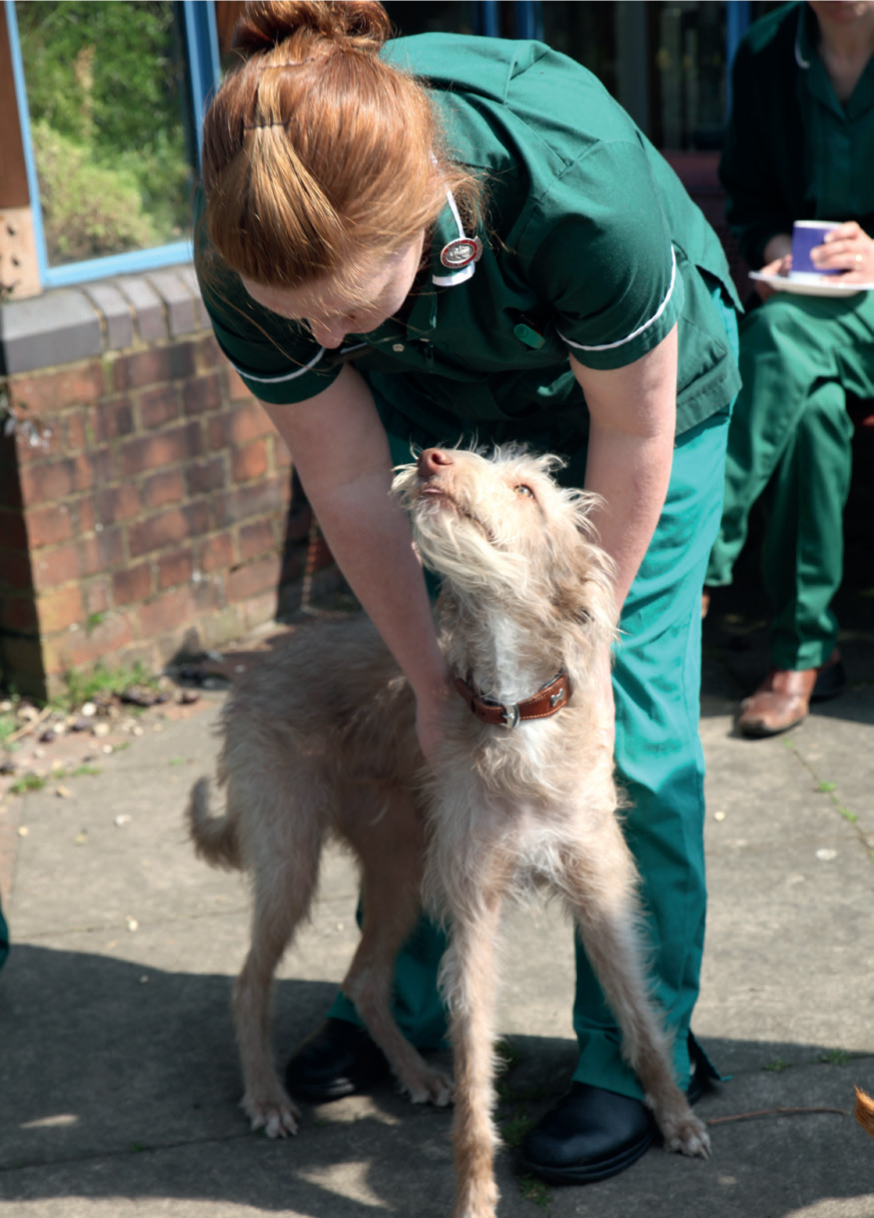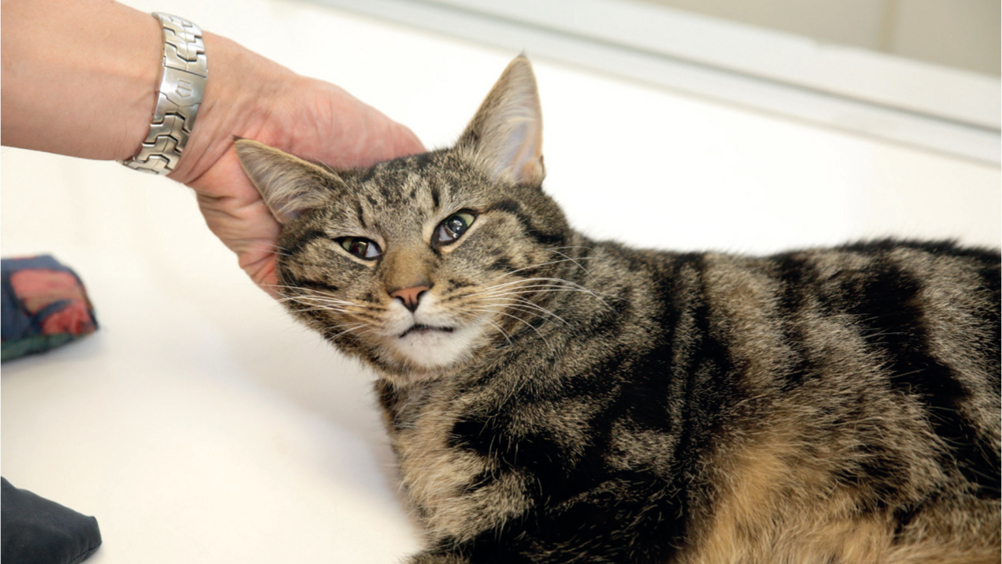In recent years the fields of both human and veterinary medical treatment have started to assess the welfare implications of hospitalisation. Hospitalisation can result in decreased sleep quantity and quality, physical and social stress, circadian rhythm disruption, and altered feeding patterns; these often compound patient anxiety and ultimately patient recovery (Lefman and Prittie, 2019). Although no complete studies have been completed in veterinary medicine, comparisons can be drawn from analysis of the adverse effects on mental health of long-term hospitalisation in human medicine (Chahraoui et al, 2015), and from records of stress and anxiety in animal shelters. Some relatively simple improvements to veterinary nursing practices have the potential to significantly mitigate these concerns.
Anxiety and stress both result in activation of mechanisms meant to preserve the organism and restore homeostasis. These are known as the ‘stress response’ and are regulated via the sympatho-adreno-medullary (SAM) and the hypothalamic-pituitary-adrenal (HPA) axes. The response of the SAM and HPA have been linked to patient morbidity and mortality (Lefman et al, 2019). Immunosuppression causing upper respiratory infections and the reactivation of infectious agents such as feline herpes virus has been linked to stress response in shelter cats (Tanaka et al, 2012). Although the hospital environment is slightly different it may still cause immunosuppression and result in similar infections. Cutaneous disease and delayed wound healing are also dramatically affected by the stress response, due to the impairment of the skin barrier permeability increasing the risk of local infections, such as Pseudomonas aeruginosa, Staphylococcus aureus and Staphylococcus epidermidis. These not only infect the individual but can infect the hospital environment too (Holmes et al, 2015). Gastrointestinal disease is also thought to be influenced by stress, due to alteration of intestinal microflora causing inflammation, and transport of intestinal bacteria along the mucosal surfaces causing infection. These can all lead to vomiting, diarrhoea, weight loss and inappetence, potentially resulting in serious nutritional issues for the long-term patient (Lefman et al, 2019). It is therefore important to create a stress-free ward environment that provides optimal patient outcomes in the long-term patient.
Hospitalisation is often a very distressing time for the patient; especially those with prolonged recovery periods that require further procedures and treatments. The ability to identify possible causes of social and physical stressors is imperative in minimising the effects of hospitalisation. In human medicine social stressors which have been identified in intensive care units (ICU) include reduced contact with family members, the abnormal environment, ongoing stresses of tests, and the comparative reduction in freedoms available at home (Karnatovskaia et al, 2017). It is conceivable that animal patients would experience similar stressors.
Sensory considerations
The ICU is regarded as the most stressful place in the hospital due to the high intensity of cases, the noise of machines, and artificial lighting. A study conducted by Fullagar et al (2015) measuring sound levels in two veterinary ICUs found that the noise levels were similar to those found in human ICUs. Both ICU readings exceeded World Health Organisation (WHO) and Environmental Protection Agency (EPA) recommendations, and the noise levels were assessed to be harmful to patient outcomes (Fullagar et al, 2015). Unfamiliar noises from ventilators and monitors are believed to cause the greatest amount of stress in human medicine (Weinhouse et al, 2006). The effects of these have not been recorded in similar detail for veterinary patients, however a study on the effect of kennel noise on canine hearing found that prolonged periods of loud noise can have detrimental effects on the patient (Scheifele et al, 2012). In human medicine studies have shown that the use of headphones can help to isolate patients from machine noise and encourage relaxation (Pagnucci et al, 2019). Similar studies on the use of music to help relieve stress have been conducted in animal rescue centres. Bowman et al (2015) described how the use of classical music for 6.5 hours a day for kennelled dogs reduced cortisol levels in the saliva significantly compared with the dogs that did not have the music. Relaxing, calming music could be used in the ward situation to help mask the machine sounds and noises from other patients. However, the choice of music is reportedly key in managing stress: punk or rock music is more likely to cause excitement rather than generating calm. Although classical music may not be the veterinary team's ideal choice, the primary aim should be to provide auditory enrichment to patients in order to reduce stress (Alworth and Buerkle, 2015). Other methods for reducing noise could include turning down warning sounds on fluid pumps and syringe drivers; placing noisy patients in one area of the kennel area away from sensitive or nervous patients can also help to minimise noise-induced stress. The use of eye masks and earplugs for ventilated or sedated noise sensitive patients can help keep them calm and less reactive to the environment around them (Herron and Shreyer, 2014). Ensuring that the ward has quiet time during the day and night will help with stress reduction and anxiety.
Environmental considerations
Hospital kennels have been constructed for efficiency and cleanliness rather than providing patients with a safe haven. Kennels made out of fibreglass or plastic are better suited to the ward setting (Rodan, 2010) as they are less acoustic and reflective, however most kennels in the hospital setting are made from stainless steel. The use of yoga mats, towels and padded bedding can help to decrease reflectivity and noise reverberation. Nearly all kennels in the hospital ward provide no hiding space and are normally designed in rows opposite each other; recent studies have suggested that this can add to patients' stress (Levine, 2008; Lefman and Prittie, 2019). Morgan and Tromborg (2007) discussed the effects of the kennel environment on natural behaviours and the limitations caused when patients are admitted into the ward environment. Consideration should be given to the medical condition/injury that the patient is admitted with, however selecting the correct kennel size will enable the patient to move freely and hide if required. Alterations should be made to ensure the welfare of the patient when admitted to the veterinary hospital (Moberg, 2000).
The introduction of the cat friendly practice has highlighted the requirement for segregated wards and treatment spaces. Housing feline patients away from canine patients helps to reduce visual and auditory stress. The use of perches, igloo beds, cardboard boxes, and a towel covering part of the kennel front can provide cats with an environment in which they feel safer (Levine, 2008). Providing these also gives the patient somewhere to rub its face to release the F3 pheromone, which will reassure the cat that they are in their own territory. Rodan et al (2011) discussed the use of this F3 pheromone in the hospital environment and it is now recommended as part of the Feline Friendly Clinic Scheme. The use of Feliway synthetic F3 pheromone (Ceva) in the hospital environment is believed to increase patients' food and water intake and reduce signs of behavioural stress (Pereira et al, 2016). The provision of toys can help to increase stimulation and prevent boredom in the long-term patient, although consideration for hygiene must also be made. Positive human interaction should be considered for the long-term patient as an important part of their care. A study conducted by Gourkow et al (2014) in shelter felines found that 10 minutes of gentle stroking four times a day improved behavioural signs of contentment over 10 days; although this was observed in a shelter it could be adapted to the veterinary environment. Implementing this into patient care should be considered, however it will be patient dependent, and should only be performed when positive interactions occur (Figure 1).

Canine patients need similar consideration as they too can feel frustrated when they are restricted and cannot escape from threatening smells or sounds around them. Padded bedding and appropriate kennel size are imperative to allow patients to move around and avoid contact with any urine/faeces passed. Most kennels are face to face, which can increase stress in the anxious, un-socialised canine patient. Providing patients with suitable toys and using alternative feeding methods like puzzle feeders can help alleviate boredom and stressors associated with this. Positive human interactions are also believed to have a calming and relaxing effect on canine inpatients (Haug, 2008). A study by Menor-Campos et al (2011) found that combining exercise and human interaction in shelter canines for 25 minutes a day increased their tolerance for new stimuli and significantly decreased saliva cortisol levels compared with canines that did not have the same interactions. This could be adapted for use in the hospital setting, especially for the long-term patient. Ensuring that all canine patients have time outside — even if they have to be carried out — is important for stimulating their senses and helping to alleviate boredom (Figure 2). Use of the dog-appeasing maternal pheromone to help reduce stress and anxiety in hospitalised patients is controversial. Lefman and Prittie (2019) suggested that previous studies regarding the use of pheromones have been insufficient and lack the evidence to support its use. The use of diffusers in practice though will not harm patients and may prove effective in some cases.

Sleep deprivation
Sleep is an important factor for the body's repair system, growth and homeostasis, and is something that is often disrupted in the hospital environment. Prolonged sleep deprivation can cause multiple adverse effects on patient recovery (Tembo and Parker, 2009). The canine sleep cycle is a 24-hour rest-activity period of which an average of 10 hours is spent daily on sleep — predominantly at night (Fullagar et al, 2015). Feline patients however have a flexible sleep cycle and require 12 hours of sleep per day (Lefman and Prittie, 2019). Due to the different environment and other sensory factors it is doubtful that any patient sleeps enough while in hospital. Ongoing treatments and medications used in nearly all patients will affect sleep patterns. This highlights the importance of promoting quiet times in the ward. Treatments overnight should ideally be grouped together when possible so that the patient gets a break in between and can relax without interruptions. Lights should be turned down low, or off if possible, in the ward overnight to allow patients without treatments to sleep. Night time should also be a quiet time so noise from staff should be kept to a minimum to assist patients in sleeping. Covering part of the front of the kennel can also assist in this regard.
Nutrition
Providing the correct nutritional requirements for the patient is an important part of the recovery period. It has been acknowledged that there is a link between stress and a patient's food intake. Delaney (2006) discussed the importance of creating a stress-free atmosphere by reducing noise and normalising the feeding patterns where possible. Malnutrition has been associated with increases in mortality, infectious morbidity and prolonged hospitalisation (Ackerman, 2019). Each patient should be assessed individually, and normal diet recorded. The patient's resting energy requirement (RER) should be calculated after the patient has been weighed; this should be done every day to ensure any weight loss or gain can be noted. Anorexia is one of the most common complaints for a myriad of disease processes. The importance of ensuring adequate nutrition is paramount; any patients that have been inappetent for 3–5 days are candidates for assisted feeding. Strategies for encouraging the patient to eat should include creating a suitable environment. Consideration should be made for the types of food bowls used along with placement in the kennel — for example cats like food and water bowls ideally to be in separate areas away from litter trays and sleeping areas (Delaney, 2006). The light/dark cycle can also affect a patient's eating, so 24-hour lighting should be minimised. The use of strong-smelling food, changing from dry food to wet food, and ensuring that food is suitable for the patient's condition can all help to encourage the patient to eat. Grooming and stroking the patient can also help to improve the patient's food intake (Ackerman, 2019).
Nursing considerations
As discussed throughout, the requirement for a stress-free environment is important for positive outcomes. The effect stress has on psychological and physiological factors can have a significant impact on the long-term inpatient if not properly managed and can affect recovery times. Nursing considerations should take into account environmental enrichment, nutrition requirements, effects of ongoing treatments, and interactions with humans and nature. As reported in human medicine, positive patient outcomes are improved by nature-based interactions and supported recuperation (Minton and Batten, 2016). The use of toys, music, quiet times, exercise and interaction with humans is proven to improve both feline and canine behaviours and reduce stress and anxiety. These are all easy to incorporate into the veterinary practice and should be part of the holistic approach to assessing patients.
The use of prescription medications where indicated by the veterinary surgeon could also help to minimise the effects of stress and anxiety, especially when patients have long periods of confinement during recovery. The use of acepromazine and medetomidine in the anxious stressed patient during recovery periods can help to minimise the clinical signs of stress. However, for the long-term inpatient a continued use of sedation could make assessing improvements difficult. A study by Gruen et al (2014) found that using trazadone hydrochloride in canine patients in post-surgical confinement reduced their stress, and 89% of owners reported calmer more relaxed patients. A similar study in cats receiving a one-off dose of trazadone hydrochloride by Stevens et al (2016) found that cats were more relaxed during examinations. The use of this medication in practice could help long-term patients in the ward environment. All of these medications need to be prescribed by a veterinary surgeon, but should be considered in the nurse's daily assessment of the patient, as patients may require medication to alleviate the anxiety felt in the ward setting.
Conclusion
This is a topic that will continuously evolve as medicine advances. It highlights the requirement for evaluating the effects of hospitalisation on the patient and the impact that will have on recovery periods. The link between the stress response, body systems and effects on recovery has not been investigated as thoroughly in veterinary medicine as it has been in human medicine. However, it is thought to affect patient outcomes in both if it is for prolonged periods. Nurses can play an important role in decreasing patient stress and anxiety, and thus in helping to increase positive outcomes in the long-term patient.
KEY POINTS
- The ability to identify possible causes of social and physical stressors is imperative in minimising the effects of hospitalisation on inpatients.
- Psychological and physiological factors can have a significant impact on the recovery of long-term inpatients.
- The use of toys, music, quiet times, exercise and human interactions can reduce stress and anxiety in both feline and canine patients.
- Nurses should take into consideration all aspects of the patient's care to assess the patient's level of stress and anxiety.
- The effects of on-going treatment and interactions should be taken into account.


